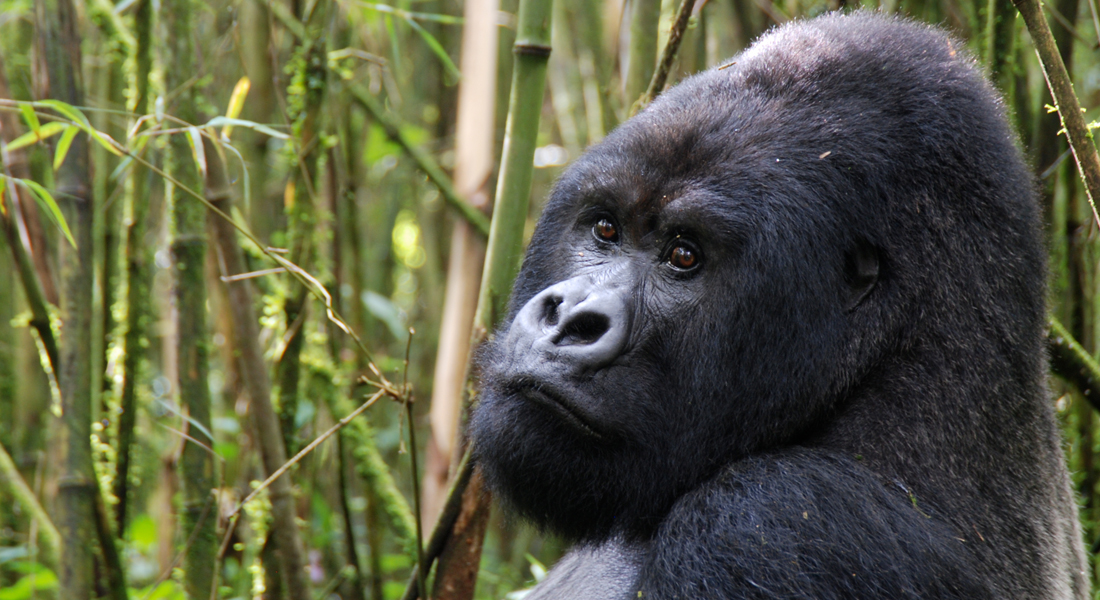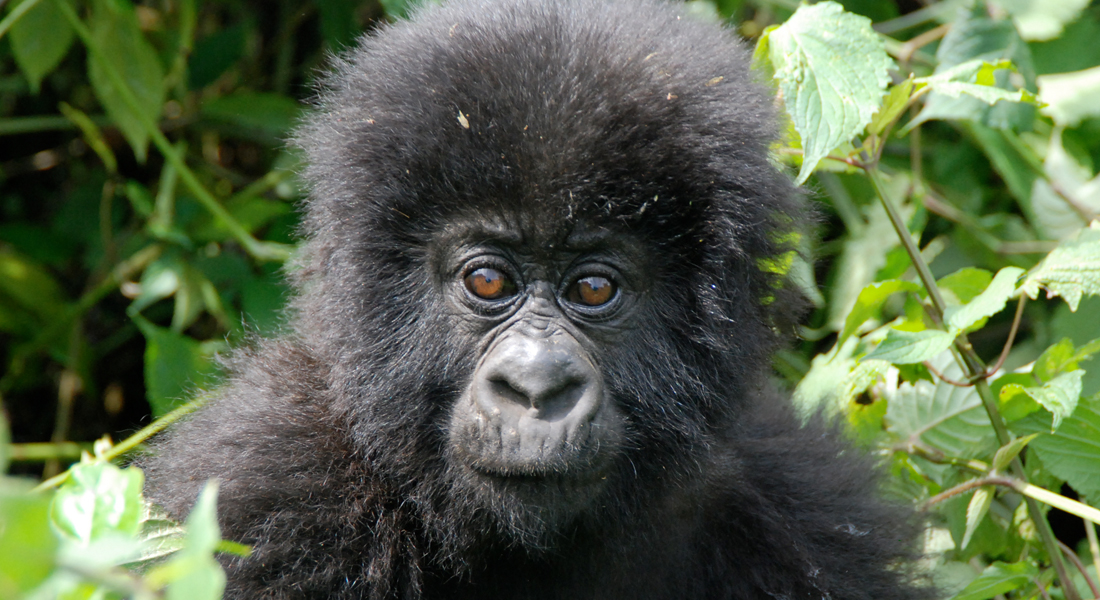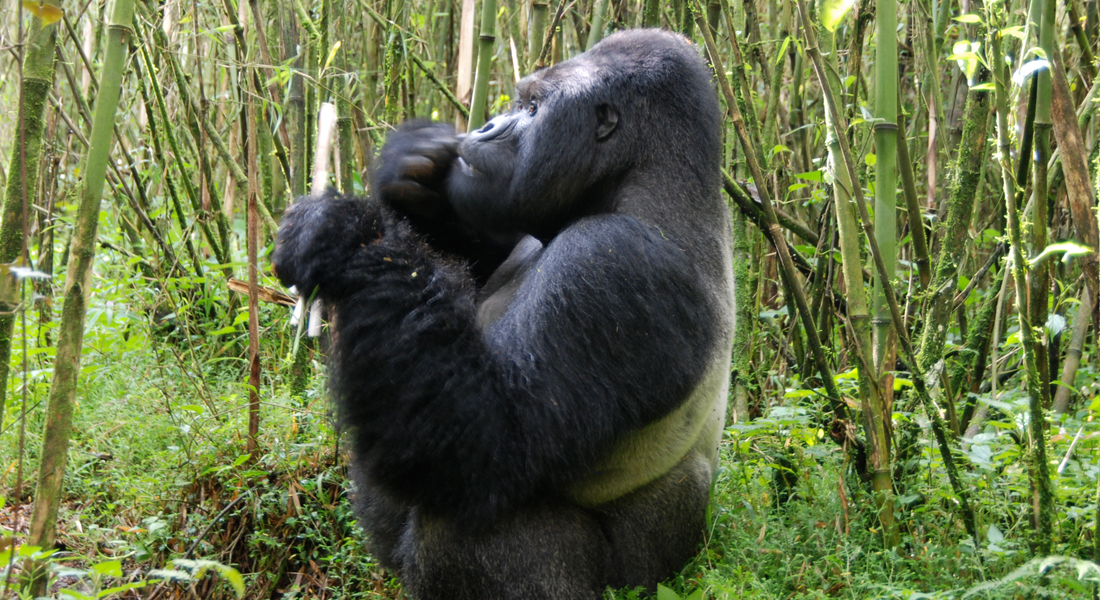Mgahinga Gorilla National Park is the smallest park in Uganda and is located on the slopes of the great Virunga volcanoes in Uganda. It is the only park where golden monkeys can be found, and it is home to one habituated gorilla family known as the Nyakagezi gorilla family. Mgahinga borders the great Virunga volcanoes in Rwanda and the Democratic Republic of Congo. The British government designated the national park as a game sanctuary in 1930 to protect the highly endangered wildlife that made it home; in 1991, the area was elevated to national park status.
The three volcanoes that make up Mgahinga Gorilla National Park give a stunning background to the area as they are located on the Virunga slopes of Sabinyo, Gahinga, and Muhavura, which are a member of the 8 Great Series of the Ranges. Gahinga is the smallest; locals referred to it as a “pile of stones.” Muhabura, which means the guide, refers to the mountain’s former illumination, which let travellers to climb it at night. Additionally, Sabinyo was given the nickname “old man’s teeth” due to its teeth-like appearance due to weathering.
Aside from the mountain gorillas, which are the park’s primary residents despite their migratory habits, there are over 30 different species of mammals that live there, including elephants, giant forest hogs, and leopards, though these animals are rarely spotted among the mountain gorillas. Over 79 different bird species may be seen in the park, including those that are unique to the area, including the Rwenzori turaco and crowned cranes.

The local farmers’ land in bush and grass, which is the lowest region, is being abandoned and regenerated as part of the national park. The vegetation of the national park differs in several altitudinal bands. As the altitude rises, the zones continue to the montane woodland, a bamboo zone, where the majority of the species remain, a montane forest, and the gigantic heathers.
The Bafumbira, who live in Kisoro district, are the other national park residents. The batwa (pygmies), a group of the last short-structured people in Uganda, once lived in the national park. However, due to conservation efforts, they were driven out of the forest and forced to continue living in nearby communities while maintaining their old ways of life as depicted in cultural performances. The Batwa were hunters and keepers who were always close to the forest.
The ideal times to visit the national park are from December to February and from June to August. The dry seasons are short, but it should be remembered that it might still rain throughout them, especially at night. The national park experiences 150 oC of heat. The national park is frequently shrouded in mist during the wet seasons, which run from March and April through September and November. For a better experience, wearing warm clothing, well-fitting boots, hand gloves, rain gear, and water-resistant coverings for phones and cameras is essential.
Beautiful features surround the park and serve as tourist attractions within the national park. On Lake Mutanda and Lake Mulehe, they are utilised for boat tours, canoeing, and a variety of other sports. Lake Bunyonyi, the deepest lake in Uganda, is located outside the park. Gorilla trekking, finding golden monkeys, mountain climbing, birding safaris, and led nature walks are other activities. It is important to purchase gorilla and golden monkey permits in advance to prevent delays, particularly during the busiest travel times.
The park is 524 square kilometres in size and is located in the Virunga ecoregion in the southwest of Uganda, near the Albertine Rift. To get there by car, you must go through Mbarara, Kabale, and Kisoro. Domestic planes from Entebbe or Kampala-Kajansi can arrange chatter flights to the Kisoro airport. The national park offers a variety of lodging options, from luxurious to the most affordable, including the Chameleon Hill Lodge and the Lake Mulehe Gorilla Lodge.
TOURISM ATTRACTIONS IN MGAHINGA NATIONAL PARK
The Nyakagezi gorilla family of mountain gorillas resides in Mgahinga National Park. The smallest of the national parks, with three peaks of Mgahinga, Sabinyo, and Muhabura, and an area of 33.7 square kilometres, it is known as “where gold meets silver” and is a continuation of the eight series of the great Virunga mountains in Uganda. Primates are the park’s most well-known attractions, and its ecological setting supports the survival of the species.

The flora and fauna, the slopes of the Mgahinga are covered by a series of vegetative covers, from the lowest parts covered in grass and bush to the undisturbed bamboo zone, montane forest, and the ericaceous zone containing the giant tree heathers, it keeps the rare golden monkeys and approximately 39 species of mammals although they are rarely seen. The Rwandan Volcanoes National Park and the Democratic Republic of the Congo are more evidence that the gorillas in this specific park are migratory because they readily transition from one ecology to another. More than 70 different bird species call it home, including the endangered Rwenzori turaco and black kites, to name a few.
Mountain gorillas and golden monkeys are two primates that live in the national park; monitoring them is one of the most incredible experiences. The Nyakagezi gorilla family is one of the 13 kinds of primates that have been identified in Uganda’s national parks. Tracking mountain gorillas involves purchasing gorilla permits in advance and starts in the morning. The golden monkey is a critically endangered species that lives in the bamboo forest. It is rare and exclusive compared to other primates, and it has a distinctive and outstanding colour that is endemic to the Albertine Rift Valley region. Golden monkeys live in groups of 100 and are led by an Alpha male. They frequently eat leaves, seasonal fruits, bamboo shoots, insects, and leaves.
Peaks in the national park are mountain Sabinyo (3669m), Gahinga (3474m), and Muhabura (4127m), which are three of the great Virunga mountain ranges. Situated at the northern end of the Albertine rift valley, they provide a chance to walk to the mountains, and the names of the three peaks have a local origin. Muhabura means “guide,” and it is believed that the mountain formerly served as a source of natural illumination for travellers during the 15th century. Sabinyo gets its name from the mountain’s ragged top nature, which has weathered to resemble an old man’s teeth, and Gahinga comes from a little pile of stones. A dense bamboo forest is traversed on ascents and descents to the summits.
A few kilometres outside the national park, Lake Mulehe and Lake Mutanda are popular tourist destinations. Boat cannoning, fishing, and the opportunity to interact with nature are all available there. The experience is further enhanced by the forest and the lake’s cool breezes.

The batwa (pygmies), one of the last organised groups in Uganda, were hunters and gatherers who coexisted peacefully with other forest animals. They were the forest keepers. They continued to live in the area surrounding the national park after being forced out of the forest for conservation reasons, passing on their culture through traditional performances to succeeding generations.
The deepest lake in Uganda, Lake Bunyonyi, lies outside the park; it is located in the Kabale area and is surrounded by several picturesque islands. Bwindi Impenetrable National Park and Queen Elizabeth National Park may be visited together on safaris; they are both controlled by the Uganda Wildlife Authority and are 542 square kilometres away from Entebbe by road. From Entebbe or Kajansi, chartered flights can be arranged to Kisoro.
TOURISM ACTIVITIES IN MGAHINGA NATIONAL PARK
Gorilla Trekking.
One of the most fascinating activities on a Ugandan experience is tracking gorillas in Mgahinga National Park, which is home to one gorilla family, the Nyakagezi. This family is mobile and occasionally travels to Rwanda and the Democratic Republic of the Congo. Tracking starts in the morning at the Ntebeko gate and lasts for 2–8 hours depending on how far the gorilla family has travelled. The maximum amount of time you can spend with these magnificent animals is one hour with a trained guide.
Golden monkey tracking.
Golden monkey tracking is done in the national park because these animals take their time to build nests and stay put all the time, unlike mountain gorillas. Golden monkeys are attractive to look at because of their orange-gold colouring, which makes for captivating photographs. An hour with these majestic animals is given during tracking, which begins at 8 a.m. It is important to reserve tracking permits for golden monkeys in advance, much like for gorillas.
Mountain climbing.
Mount Muhabura is the highest peak, rising to a height of 4127 metres above sea level. Sabinyo and Gahinga hikers can enjoy stunning views of the Virunga mountain range, Lake Bunyonyi, Lake Mulehe, Lake Mutanda, and the neighbourhood from the summit. The trip takes 8 hours, depending on how quickly the last hiker finishes. The majority of the hikes pass through forests, providing opportunities to see golden monkeys and various bird species.
Bird Watching.
The Rwenzori turaco, black kites, bronze sunbird, Rwenzori batis, black headed waxbill, and streaky seedeater are just a few of the birds that may be sighted in the national park, which is home to more than 70 different kinds of birds. It is advised to have a pair of binoculars and be accompanied by an experienced birder who can assist you identify the many bird species in order to fully enjoy your birding experience.
Batwa cultural experience.
The displaced pygmies developed the Batwa cultural experience as a means of educating their kids, handing down to future generations, and showcasing their heritage and customs to the entire world. The Batwa males in Uganda are very different in stature from the men of nearby tribes; both men and women are typically little taller than four feet; they have strong social ties and are aware of their shared identity. A day spent with these people provides you the chance to walk in the forest with people who are familiar with and knowledgeable about it. They will help you experience the forest from their perspective, and you will also have the option to visit the homes of the Batwa community, learn about their traditional meals, and hear about their tales and songs.
The park is 540 square kilometres and an 8-hour road trip through Kabale and Kisoro from the nation’s capital away in the south-western corner of the continent. You may arrange charter flights from Entebbe or Kajansi to the Kisoro airstrip. The national park offers lodging options ranging from the most affordable to the most opulent, therefore it is advised to bring warm clothing, boots, rain gear, insect repellents, hand gloves, and any other personal items required for an African safari.
WHERE TO STAY IN MGAHINGA NATIONAL PARK.
The national park has several accommodation facilities around ranging from the best budget to luxury.
Gahinga Gorilla Lodge.
Gahinga Gorilla Lodge is a luxurious establishment in Mgahinga National Park, the only place to stay while tracking mountain gorillas (Nyakagezi gorilla family). It is one of the lodges amazing places located right outside the park, meaning you can carry out activities by conveniently taking a walk to the start point. The picturesque views of the lodge are worth staying at. The lodge provides lodging in 9 exquisite bandas, each with a balcony overlooking Lake Mutanda, the mountain ranges, and the lush greenery. Each banda has a hot shower and a wide bed. The main lodge has WIFI connectivity, a modern sunroom (lounge), bar and eating area. It was built using local materials like stone. The historic lounge and library behind the main lodge are furnished in a similar style to the remainder of the lodge and are made of open fire logs.
A restaurant, bikes for rent, a lounge area with a fire place, a bar, and a large mask of Congolese masks are all features of the Travellers Rest Hotel in Kisoro, one of the oldest facilities in Uganda. It is located 14 km from the national park and offers accommodation in eleven rooms with views of the Virunga mountains. All of the rooms are also well-equipped with warm water and private bathrooms.
Amajabere Iwacu Community Camp.
Amajabere Iwacu Community Camp is a low-cost establishment close to the camp. Three of the peaks are immediately adjacent to the lodge and offer a variety of rooms from bandas to dormitories to camping; the camp also has a restaurant serving typical Ugandan cuisine.
Chameleon Hill Lodge.
An upscale lodge with a view of Lake Mutanda, Chameleon Hill Lodge is a great location for birding, boating, and participating in other national park activities like tracking gorillas and golden monkeys. It is reasonably priced, has permanent cottages that are built with en-suite bathrooms, and is situated so that visitors can track in both Bwindi Impenetrable National Park and Mgahinga.
Other lodges, such as the Lake Mulehe Gorilla Lodge, Nkuringo Lodge, and Bwindi Safari Lodge, to name a few, are on the property that is next to Lake Mulehe. The tracking location is a few kilometres from the lodges, therefore it is relatively feasible to drive there. Due to the high altitude of Mgahinga National Park, it is advised to bring warm clothing, boots, waterproof coverings for phones and cameras, rain gear, and any other equipment required for an African safari.
BEST TIME TO VISIT MGHAINGA NATIONAL PARK
Mgahinga Gorilla National Park is open all year round, but the best times to visit are between December and February and June and August because the trails are much drier and easier to navigate, making for a wonderful encounter with the gorillas. Because this is the busiest time of year for tourists, it is advised to purchase gorilla permits well in advance. It should be emphasised that the park region is not often as dry as one might assume; in fact, even now is the finest season to go mountain biking and participate in the majority of park activities.
The national park is frequently shrouded in mist during the wet seasons, which run from March and April through September and November. Warm clothing, well-fitting boots, hand gloves, rain gear, and water-resistant covers for phones and cameras are essential for a better experience, but one should keep in mind that the paths are always slick in comparison to the warmer season, and it may be challenging to spot some animal species. The parks experience prolonged rainy seasons and shorter dry seasons, with temperatures up to 150 oC.
Mgahinga Gorilla National Park is home to a number of tourist favourites, including the golden monkey and mountain gorillas. Uganda is also home to 13 species of monkeys, including the l’hoest monkey, black-and-white colobus monkey, blue monkey, and red-tailed monkey. The national park also contains large animals like elephants and buffaloes, though they are rarely seen. The presence of bird and butterfly species makes it a healthy ecosystem that, at the very least, everyone would love to visit.
Bwindi Impenetrable National Park, a UNESCO World Heritage Site that was gazetted as a way to protect the endangered species, is home to half of the remaining mountain gorillas in Uganda. Activities like mountain climbing, gorilla tracking, and golden monkey tracking are exclusively unique and can only be found in the national park. It is advised to bring appropriate clothing when visiting the national park because of the frigid climate there.
The Democratic Republic of the Congo, Rwanda, or Uganda can all be seen from its advantageous location at the base of the volcanoes in the national park’s southwest section.

